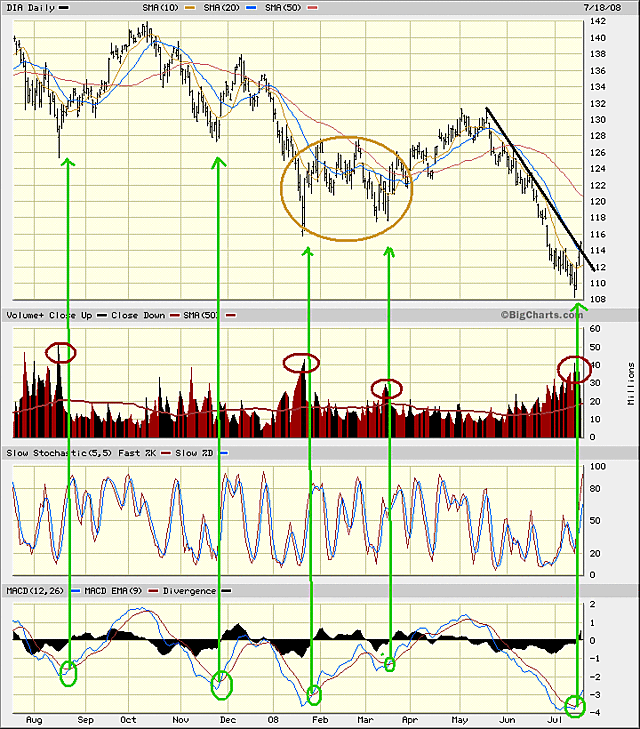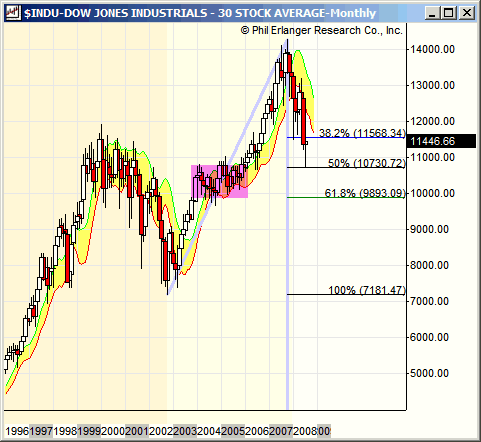Here is the direct link. From John Carter.
Trading
-
Before He Trades Video
This tongue-in-cheek music video, called "Before He Trades," re-makes a popular Carrie Underwood song as a trading reminder. -
Resilience

Watching the Olympics
has been an uplifting reminder for me. The sport of it is fun to
watch. Yet, the deeper story is even better.For example,
Michael Phelps was expected to break Mark Spitz's record in Athens
four-years ago. While he was dominating, it just didn't happen, then.Can you imagine setting world records, winning gold medals, and still feeling like you came up short?
Can you imagine how many times he replayed the missing hundredths of a second that separated him from his dream?
So how did he do it this time?Somehow
the great ones are resilient and durable in distressing situations.
They adapt and cope; and ultimately gain strength from adversity —
often converting it into a gift. They find a way to transform what
seemed like setbacks into the fuel they need to get to the next level.Nietzsche
said "that which does not kill me, makes me stronger." And that
statement applies to trading and funds management as well. Trading
often seems like it is not fair – and that can be very good for us. -
Resilience

Watching the Olympics
has been an uplifting reminder for me. The sport of it is fun to
watch. Yet, the deeper story is even better.For example,
Michael Phelps was expected to break Mark Spitz's record in Athens
four-years ago. While he was dominating, it just didn't happen, then.Can you imagine setting world records, winning gold medals, and still feeling like you came up short?
Can you imagine how many times he replayed the missing hundredths of a second that separated him from his dream?
So how did he do it this time?Somehow
the great ones are resilient and durable in distressing situations.
They adapt and cope; and ultimately gain strength from adversity —
often converting it into a gift. They find a way to transform what
seemed like setbacks into the fuel they need to get to the next level.Nietzsche
said "that which does not kill me, makes me stronger." And that
statement applies to trading and funds management as well. Trading
often seems like it is not fair – and that can be very good for us. -
Weekly Commentary through August 8th 2008
The Markets are up, but relatively trendless. Yes the recent lows have held, and I'm seeing higher lows (and that is a bullish sign). However, recently, the thing to note has been the markets' volatility. For the Dow, there have been seven 200-point up or down days and two 300-point up days … but in that time, the Dow is only up 36 points. It is tough to hold trades overnight in this type of trading environment. Going home bullish or bearish hasn't led to peaceful sleep lately.
Here are some other stats to ponder. First, 300-point rallies are pretty normal during bear markets (and in the beginning of new bull markets). Also, It is quite normal to have intermediate term rallies in bear markets that last 2-3 months. The last one lasted 2 months; but only had narrow leadership in the Commodities. This time the leadership is much broader (most everything, except Commodities).
Also this week, the Fed held rates steady, and the US Dollar Index now trades above its 50-day and 200-day
moving averages, signaling a breakout from its five-month trading range.
Here are a few of the posts I found interesting this week:
- IPOs at 5-Year Low, Worldwide (WSJ)
- Wharton Finance Professor, Jeremy Siegel Calls a Market Bottom (Morningstar)
- Rackspace IPO loses 20% on first day of trading (WSJ)
- President Bush: "Wall Street got drunk"…"and now it's got a hangover" (Wall $t. Folly)
- Does the 4-Year Presidential Cycle have predictive power in the markets? (CXO Advisory)
- Too many ETFs, too little volume; the weakest are closing (Bespoke)
- Crisis Averted: Improvisation is one thing, Policy is another (NYTimes)
- Foreign money buying US properties at deep discounts (NYPost)
And, a little bit extra:
- Big Brother is watching: Apple shuts down "I Am Rich" Application for iPhones (Download Squad)
- Innovations show how water-starved countries could solve their food crises (NYTimes)
- At $6BB spent, Olympic Security is No Game; but they do ride Segways (BusinessWeek)
- Twitter's micro-blogging success suggests I'm old, because I still don't get it (Fortune)
- Caffeine Myths De-Bunked; go get a cup of coffee (NYTimes)
-
Weekly Commentary through August 8th 2008
The Markets are up, but relatively trendless. Yes the recent lows have held, and I'm seeing higher lows (and that is a bullish sign). However, recently, the thing to note has been the markets' volatility. For the Dow, there have been seven 200-point up or down days and two 300-point up days … but in that time, the Dow is only up 36 points. It is tough to hold trades overnight in this type of trading environment. Going home bullish or bearish hasn't led to peaceful sleep lately.
Here are some other stats to ponder. First, 300-point rallies are pretty normal during bear markets (and in the beginning of new bull markets). Also, It is quite normal to have intermediate term rallies in bear markets that last 2-3 months. The last one lasted 2 months; but only had narrow leadership in the Commodities. This time the leadership is much broader (most everything, except Commodities).
Also this week, the Fed held rates steady, and the US Dollar Index now trades above its 50-day and 200-day
moving averages, signaling a breakout from its five-month trading range.
Here are a few of the posts I found interesting this week:
- IPOs at 5-Year Low, Worldwide (WSJ)
- Wharton Finance Professor, Jeremy Siegel Calls a Market Bottom (Morningstar)
- Rackspace IPO loses 20% on first day of trading (WSJ)
- President Bush: "Wall Street got drunk"…"and now it's got a hangover" (Wall $t. Folly)
- Does the 4-Year Presidential Cycle have predictive power in the markets? (CXO Advisory)
- Too many ETFs, too little volume; the weakest are closing (Bespoke)
- Crisis Averted: Improvisation is one thing, Policy is another (NYTimes)
- Foreign money buying US properties at deep discounts (NYPost)
And, a little bit extra:
- Big Brother is watching: Apple shuts down "I Am Rich" Application for iPhones (Download Squad)
- Innovations show how water-starved countries could solve their food crises (NYTimes)
- At $6BB spent, Olympic Security is No Game; but they do ride Segways (BusinessWeek)
- Twitter's micro-blogging success suggests I'm old, because I still don't get it (Fortune)
- Caffeine Myths De-Bunked; go get a cup of coffee (NYTimes)
-
Weekly Commentary Charts through July 18th 2008
Here are a few charts that caught my eye. The first is from the
Trading Godess site. It is from a post called, “Did someone ring a bell.” It shows
that a break above the downtrend, on volume, with MACD turning up. In
other words, it has the makings of a decent long set-up.
On the other hand Phil Erlanger had this chart, which shows that
the Dow has re-traced 50% of the move off its 2003 lows, but that it
might have a little more to go.
-
Weekly Commentary Charts through July 18th 2008
Here are a few charts that caught my eye. The first is from the
Trading Godess site. It is from a post called, “Did someone ring a bell.” It shows
that a break above the downtrend, on volume, with MACD turning up. In
other words, it has the makings of a decent long set-up.
On the other hand Phil Erlanger had this chart, which shows that
the Dow has re-traced 50% of the move off its 2003 lows, but that it
might have a little more to go.
-
How Clear is Your Market Vision, Through the Lens of Emotions?
Do lower prices frighten people? Or, do fearful people cause lower prices?
On some level, it is clear that the ebbs and flows of a Market Chart represent the collective fear and greed of its participants. As more people get fearful, you have more sellers. As more people get greedy, prices catch a bid.
But what about you and me? Are we immune from the primal portion of our brains? As I was thinking about this, I saw the following quote:
"The thoughts they had were the parents of the actions they did; their feelings were parents of their thoughts."
-Thomas Carlyle (1795-1881)
It is true, isn't it? Thoughts flow from feelings. Or (at least) feelings affect thoughts. At some level, I've known this about many discrete areas of my life (motivation, relationships, etc.). Yet I've resist accepting this as a global truth.
Nonetheless, it makes sense that understanding (or at least recognizing) what you feeling is an important step in better thinking and better actions.
Likewise, if you are a discretionary trader, it might be interesting to note how your emotions affect your trading. For example, it is pretty clear that your emotional state can create an anchor point and context that affects
judgment and even the interpretation of market signals (for example,
whether or not to take a trade).On any given day, I might get angry, happy, frustrated, excited or even
greedy. We all experience a range of emotions regularly, don't we? Yet from a trader's perspective, it might feel like nothing noteworthy is happening to them throughout the day. Why? Because traders are so used to the range of emotions they experience, experiencing them again simply feels "normal", and they learn to ignore them.As a systematic and algorithmic trader, emotions still affect my day. That is why we follow the "rules" while the market is open. Discussions about changing rules or adding new rules happen after-hours (when the fear and greed simmer down and heads clear).
Clearly, many things can affect how and when a discretionary trader
trades. Identifying and recognizing when something affects you is the
first step towards mastering it. -
How Clear is Your Market Vision, Through the Lens of Emotions?
Do lower prices frighten people? Or, do fearful people cause lower prices?
On some level, it is clear that the ebbs and flows of a Market Chart represent the collective fear and greed of its participants. As more people get fearful, you have more sellers. As more people get greedy, prices catch a bid.
But what about you and me? Are we immune from the primal portion of our brains? As I was thinking about this, I saw the following quote:
"The thoughts they had were the parents of the actions they did; their feelings were parents of their thoughts."
-Thomas Carlyle (1795-1881)
It is true, isn't it? Thoughts flow from feelings. Or (at least) feelings affect thoughts. At some level, I've known this about many discrete areas of my life (motivation, relationships, etc.). Yet I've resist accepting this as a global truth.
Nonetheless, it makes sense that understanding (or at least recognizing) what you feeling is an important step in better thinking and better actions.
Likewise, if you are a discretionary trader, it might be interesting to note how your emotions affect your trading. For example, it is pretty clear that your emotional state can create an anchor point and context that affects
judgment and even the interpretation of market signals (for example,
whether or not to take a trade).On any given day, I might get angry, happy, frustrated, excited or even
greedy. We all experience a range of emotions regularly, don't we? Yet from a trader's perspective, it might feel like nothing noteworthy is happening to them throughout the day. Why? Because traders are so used to the range of emotions they experience, experiencing them again simply feels "normal", and they learn to ignore them.As a systematic and algorithmic trader, emotions still affect my day. That is why we follow the "rules" while the market is open. Discussions about changing rules or adding new rules happen after-hours (when the fear and greed simmer down and heads clear).
Clearly, many things can affect how and when a discretionary trader
trades. Identifying and recognizing when something affects you is the
first step towards mastering it. -
Phi on Fibonacci and Markets

As noted, 6/18 is "Phi Day" for Fibonacci aficionados.So, here is a link to a description of the sequence on Prechter's Elliott Wave website.
And here is a follow-up article.
